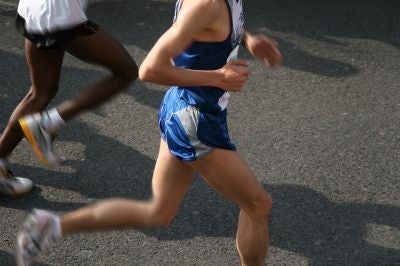Your support helps us to tell the story
From reproductive rights to climate change to Big Tech, The Independent is on the ground when the story is developing. Whether it's investigating the financials of Elon Musk's pro-Trump PAC or producing our latest documentary, 'The A Word', which shines a light on the American women fighting for reproductive rights, we know how important it is to parse out the facts from the messaging.
At such a critical moment in US history, we need reporters on the ground. Your donation allows us to keep sending journalists to speak to both sides of the story.
The Independent is trusted by Americans across the entire political spectrum. And unlike many other quality news outlets, we choose not to lock Americans out of our reporting and analysis with paywalls. We believe quality journalism should be available to everyone, paid for by those who can afford it.
Your support makes all the difference.If you're training for a marathon this year, chances are you'll want to avoid common problems such as sprains, aches, and even chafed nipples and lost toenails. Chicago-based orthopedic surgeon Dr. Benjamin Domb told Relaxnews on August 10 his tips to staying in good form while pounding the pavement.
"Make sure the shoe fits, or go barefoot," said Domb. Marathoners should try training barefoot or with thin shoes to learn how to take the impact out of their running form. Well-padded and well-fitted running shoes appropriate for your foot-type (high arch, flat foot, or normal arch) can make a huge difference in preventing injury, he adds. Runners should buy and use the shoes four to six weeks prior to the marathon.
Also, watch your hips. "Everyone has a different natural rotation of their hip and it is important to run using that natural hip rotation," said Domb, who is one of Chicago's leading experts in a minimally invasive procedure known as hip arthroscopy. Some people should run with their feet pointing straight forward, while other people are naturally pigeon-toed or duck-footed. "Don't fight nature," he adds.
Also be sure to supplement your running program with stretching. Try yoga or Pilates to keep your limbs loose and injury-free. Domb also recommended mixing up your routine to incorporate cross-training, strength training, and low-impact training such as swimming, cycling, or elliptical machines, in addition to your running regimen.
To protect your toenails, make sure to wear quality shoes and good socks that don't move around and rub when you run to allow your feet to breathe and stay dry. For uncomfortable nipple chafing, Domb recommends wearing adhesive bandages or plasters.
For more tips on staying injury-free when running: http://www.runnersworld.com/channel/0,,s6-241-0-0-0,00.html

Join our commenting forum
Join thought-provoking conversations, follow other Independent readers and see their replies
Comments